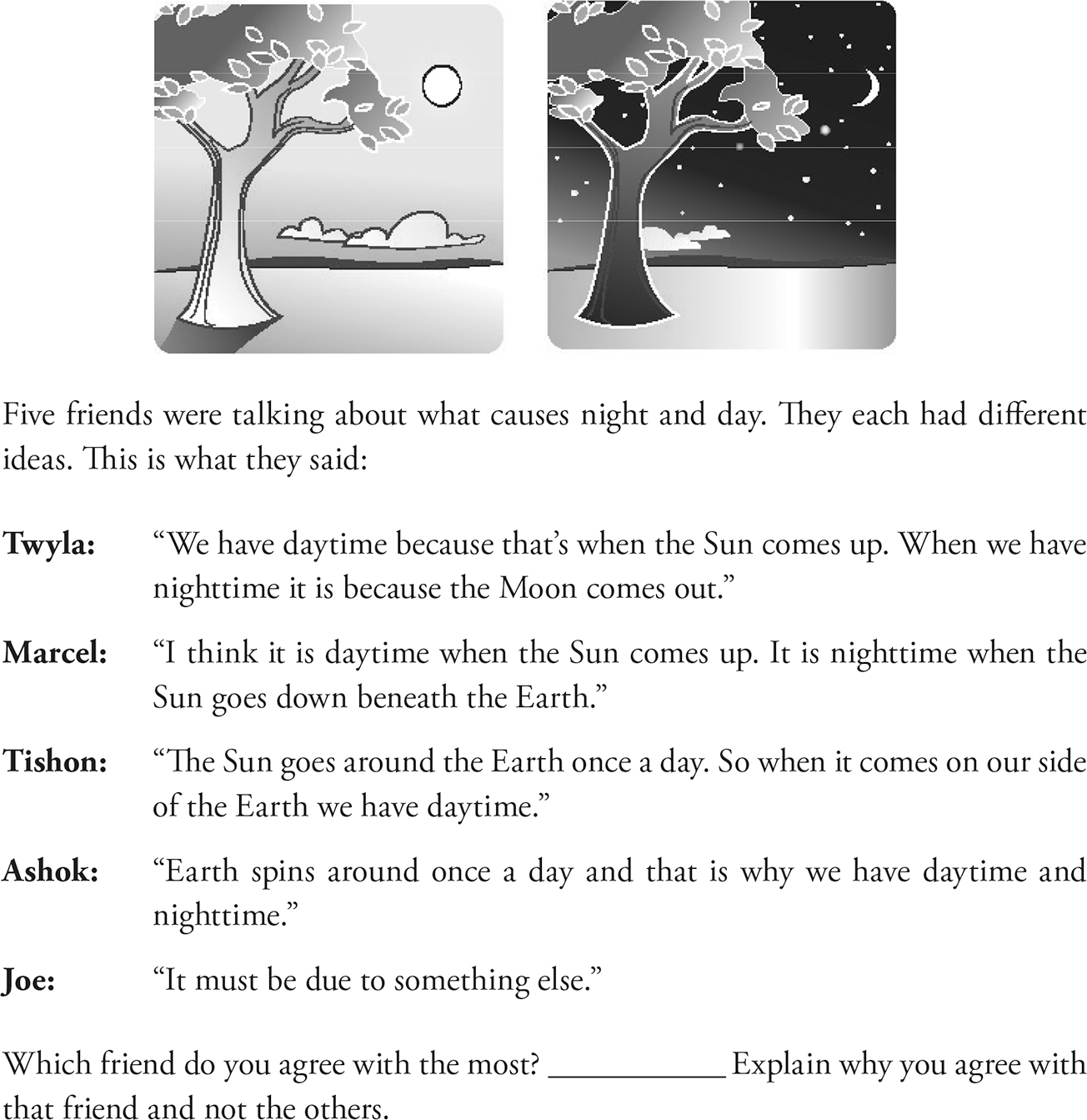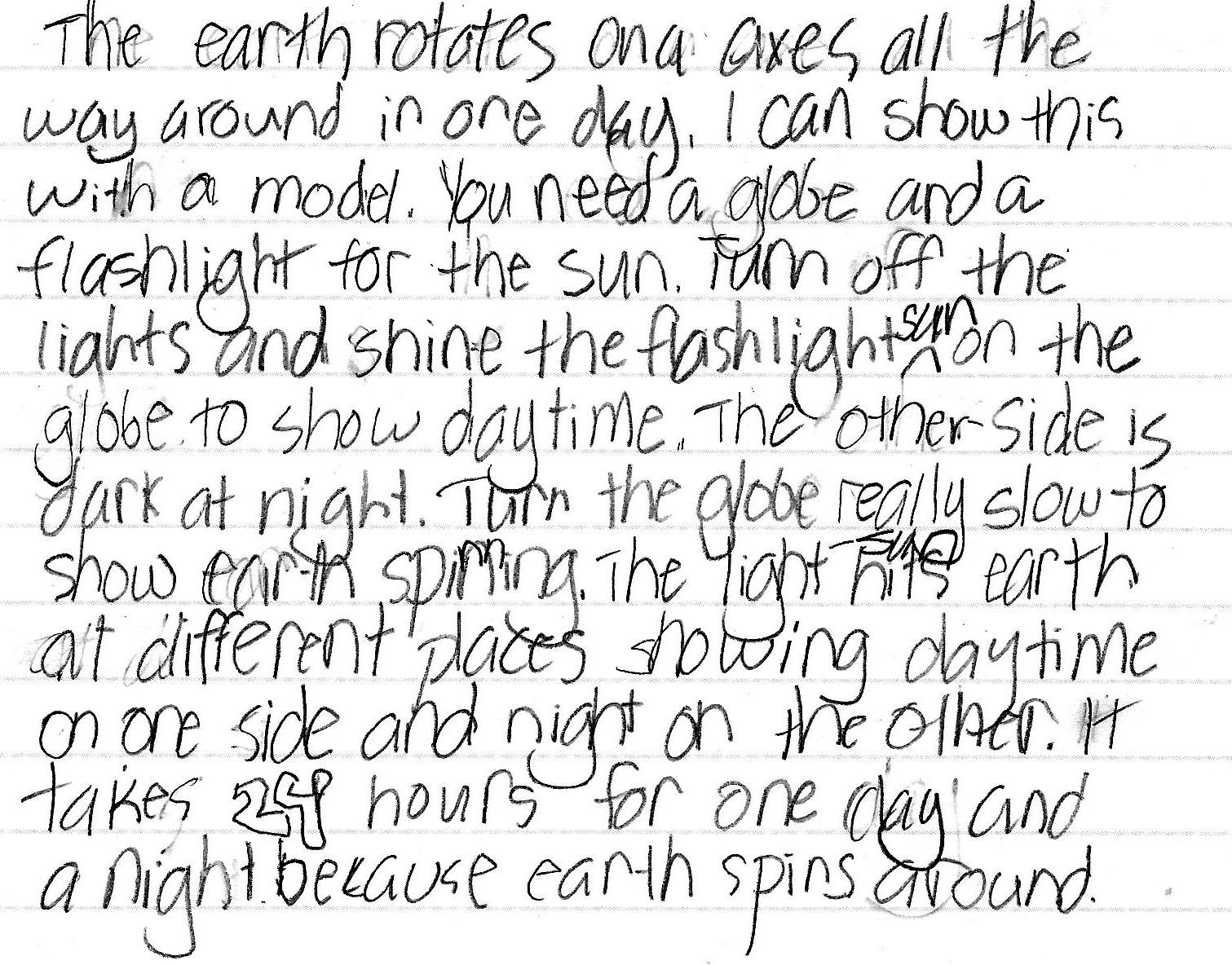Formative Assessment Probes
The Day-Night Cycle
Adding Models to Probe Explanations
Elementary students learn to use Earth’s motion to explain the observable pattern of the day-night cycle. Before they develop an understanding of the Earth spinning on its axis while moving around the Sun, their everyday experiences are likely to have contributed to initial Sun-Earth system ideas that do not involve a moving Earth. Watching the Sun rise and set and seemingly move across the sky from morning to evening may contribute to preconceived day-night cycle ideas in which the Sun is moving around a stationary Earth or moving upward in the day time and downward at night.
Before planning instruction to address the ESS1.B disciplinary core idea (grades 3–5), “The orbits of Earth around the Sun and of the Moon around Earth, together with the rotation of Earth about an axis between its north and south poles, cause observable patterns. These include day and night; daily changes in the length and direction of shadows; and different positions of the Sun, Moon, and stars at different times of the day, month, and year,” (NRC 2012), it is important to take the time to uncover students’ initial ideas about the day-night cycle. Commonly held alternative conceptions, as well as others that make sense to children, can be uncovered using the probe, “What Causes Night and Day?” (Figure 1; Keeley and Sneider 2012).

What Causes Night and Day Probe.
Examining students’ initial ideas reveals that students first need to develop an understanding that the Earth is always moving in two ways: a rotation about its axis, and an almost circular orbit around the Sun. The latter is important to address the commonly held alternative idea that the Sun is moving around the Earth, rather than the correct idea that the Earth moves around the Sun. Both of these motions exhibit a pattern—a complete rotation every day (about 24 hours) and a complete orbit every year (about 365 days). Each of these motions can be modeled for students either kinesthetically with their bodies or with objects representing the Earth and Sun. Furthermore, the concept of a north-south axis can be modeled by showing students a globe tilted on its axis. Be careful to help them understand the limitations of models by pointing out the Earth does not actually have a physical long pole that extends north to south through the Earth, such as is physically depicted on the globe. The physical axis extending on each side of the globe is there to produce the tilt on the model and helps us visualize the tilt of the Earth as it spins around.
Once these motion ideas have been developed, students can use Earth’s motion and position in relation to the Sun to explain the day-night cycle and why it seems to us from an Earth perspective, that the Sun appears to rise, move across the sky, and set. Models, such as a globe and a flashlight representing the Sun, are used again to explain the pattern of day and night. Ideally it is best to have students manipulate the model rather than observing the teacher demonstrate the use of the model. Modeling the day-night cycle phenomenon can be followed by gathering additional information from text such as Emily Morgan’s, Next Time You See A Sunset (Morgan 2013).
But how do you know whether students really understand what causes the day-night cycle after engaging in modeling activities and turning to text to further solidify their ideas? How do you know whether their initial alternative conceptions have changed as a result of using a model? How can you check to find out whether the model may have contributed to further misconceptions? Formative assessment probes are valuable tools to use at the beginning of an instructional sequence to understand the ideas and experiences students are bringing to their learning that can be addressed through informed instruction. They are equally valuable when used a second time, after students have had the opportunity to explore and develop their ideas. When using a probe the second time to check for understanding, especially after students have engaged in the practice of using a model to understand a phenomenon, ask students to extend their explanation by describing a model that can be used to support their thinking. The example in Figure 2 is from a fourth-grade student who selected “Ashkok” after revisiting the probe, following a modeling activity. He describes how to use a globe and a flashlight to support Ashkok’s idea that the “Earth spins around once a day and that is why we have daytime and nighttime.”

Student writing example.
As you select probes to use with your lessons, consider ways to have students use a model to support their explanation. Many of the probes in the Uncovering Student Ideas series lead into the development and use of models to explain phenomena. Models used in elementary classroom activities can be kinesthetic, physical replicas using objects to represent the phenomenon, or even conceptual drawings. After engaging in modeling activities, students describe how to use a model explain the phenomenon or they can draw pictures to support their explanation. Extending a probe explanation to include a model not only gives post-assessment insight into your students’ thinking about a disciplinary core idea, it also helps you determine whether the modeling activity you used in a lesson was effective in helping students understand and explain a phenomenon. It also provides an opportunity for students to use the scientific practice of developing and using a model and understand why models are important in science.
Page Keeley (pagekeeley@gmail.com) is a science education consultant and the author of the Uncovering Student Ideas in Science series (http://uncoveringstudentideas.org).
Disciplinary Core Ideas Earth & Space Science Teaching Strategies Elementary Grade 3 Grade 4 Grade 5


